α-Synuclein controls mitochondrial calcium homeostasis by enhancing endoplasmic reticulum-mitochondria interactions
- PMID: 22453917
- PMCID: PMC3365710
- DOI: 10.1074/jbc.M111.302794
α-Synuclein controls mitochondrial calcium homeostasis by enhancing endoplasmic reticulum-mitochondria interactions
Abstract
α-Synuclein has a central role in Parkinson disease, but its physiological function and the mechanism leading to neuronal degeneration remain unknown. Because recent studies have highlighted a role for α-synuclein in regulating mitochondrial morphology and autophagic clearance, we investigated the effect of α-synuclein in HeLa cells on mitochondrial signaling properties focusing on Ca(2+) homeostasis, which controls essential bioenergetic functions. By using organelle-targeted Ca(2+)-sensitive aequorin probes, we demonstrated that α-synuclein positively affects Ca(2+) transfer from the endoplasmic reticulum to the mitochondria, augmenting the mitochondrial Ca(2+) transients elicited by agonists that induce endoplasmic reticulum Ca(2+) release. This effect is not dependent on the intrinsic Ca(2+) uptake capacity of mitochondria, as measured in permeabilized cells, but correlates with an increase in the number of endoplasmic reticulum-mitochondria interactions. This action specifically requires the presence of the C-terminal α-synuclein domain. Conversely, α-synuclein siRNA silencing markedly reduces mitochondrial Ca(2+) uptake, causing profound alterations in organelle morphology. The enhanced accumulation of α-synuclein into the cells causes the redistribution of α-synuclein to localized foci and, similarly to the silencing of α-synuclein, reduces the ability of mitochondria to accumulate Ca(2+). The absence of efficient Ca(2+) transfer from endoplasmic reticulum to mitochondria results in augmented autophagy that, in the long range, could compromise cellular bioenergetics. Overall, these findings demonstrate a key role for α-synuclein in the regulation of mitochondrial homeostasis in physiological conditions. Elevated α-synuclein expression and/or eventually alteration of the aggregation properties cause the redistribution of the protein within the cell and the loss of modulation on mitochondrial function.
Figures
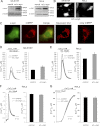
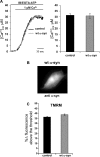
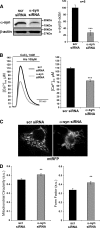
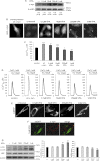
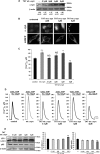


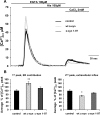
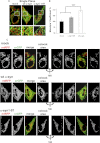
Similar articles
-
The Parkinson disease-related protein DJ-1 counteracts mitochondrial impairment induced by the tumour suppressor protein p53 by enhancing endoplasmic reticulum-mitochondria tethering.Hum Mol Genet. 2013 Jun 1;22(11):2152-68. doi: 10.1093/hmg/ddt068. Epub 2013 Feb 14. Hum Mol Genet. 2013. PMID: 23418303
-
α-Synuclein binds to the ER-mitochondria tethering protein VAPB to disrupt Ca2+ homeostasis and mitochondrial ATP production.Acta Neuropathol. 2017 Jul;134(1):129-149. doi: 10.1007/s00401-017-1704-z. Epub 2017 Mar 23. Acta Neuropathol. 2017. PMID: 28337542 Free PMC article.
-
splitGFP Technology Reveals Dose-Dependent ER-Mitochondria Interface Modulation by α-Synuclein A53T and A30P Mutants.Cells. 2019 Sep 12;8(9):1072. doi: 10.3390/cells8091072. Cells. 2019. PMID: 31547305 Free PMC article.
-
A new role for α-synuclein in Parkinson's disease: Alteration of ER-mitochondrial communication.Mov Disord. 2015 Jul;30(8):1026-33. doi: 10.1002/mds.26239. Epub 2015 May 7. Mov Disord. 2015. PMID: 25952565 Review.
-
Alpha-Synuclein Toxicity on Protein Quality Control, Mitochondria and Endoplasmic Reticulum.Neurochem Res. 2018 Dec;43(12):2212-2223. doi: 10.1007/s11064-018-2673-x. Epub 2018 Oct 28. Neurochem Res. 2018. PMID: 30370500 Review.
Cited by
-
Using mass spectrometry imaging to visualize age-related subcellular disruption.Front Mol Biosci. 2023 Mar 8;10:906606. doi: 10.3389/fmolb.2023.906606. eCollection 2023. Front Mol Biosci. 2023. PMID: 36968274 Free PMC article. Review.
-
The Interface Between ER and Mitochondria: Molecular Compositions and Functions.Mol Cells. 2018 Dec 31;41(12):1000-1007. doi: 10.14348/molcells.2018.0438. Epub 2018 Dec 12. Mol Cells. 2018. PMID: 30590907 Free PMC article. Review.
-
Therapeutic Strategies Targeting Mitochondrial Calcium Signaling: A New Hope for Neurological Diseases?Antioxidants (Basel). 2022 Jan 15;11(1):165. doi: 10.3390/antiox11010165. Antioxidants (Basel). 2022. PMID: 35052668 Free PMC article. Review.
-
Examining the Toxicity of α-Synuclein in Neurodegenerative Disorders.Life (Basel). 2021 Oct 22;11(11):1126. doi: 10.3390/life11111126. Life (Basel). 2021. PMID: 34833002 Free PMC article. Review.
-
Mitochondria-associated membranes in aging and senescence: structure, function, and dynamics.Cell Death Dis. 2018 Feb 28;9(3):332. doi: 10.1038/s41419-017-0105-5. Cell Death Dis. 2018. PMID: 29491385 Free PMC article. Review.
References
-
- Hirsch E. C., Hunot S., Faucheux B., Agid Y., Mizuno Y., Mochizuki H., Tatton W. G., Tatton N., Olanow W. C. (1999) Dopaminergic neurons degenerate by apoptosis in Parkinson disease. Mov. Disord. 14, 383–385 - PubMed
-
- Spillantini M. G., Schmidt M. L., Lee V. M., Trojanowski J. Q., Jakes R., Goedert M. (1997) α-Synuclein in Lewy bodies. Nature 388, 839–840 - PubMed
-
- Thomas B., Beal M. F. (2007) Parkinson disease. Hum. Mol. Genet. 16, R183–R194 - PubMed
Publication types
MeSH terms
Substances
LinkOut - more resources
Full Text Sources
Miscellaneous

